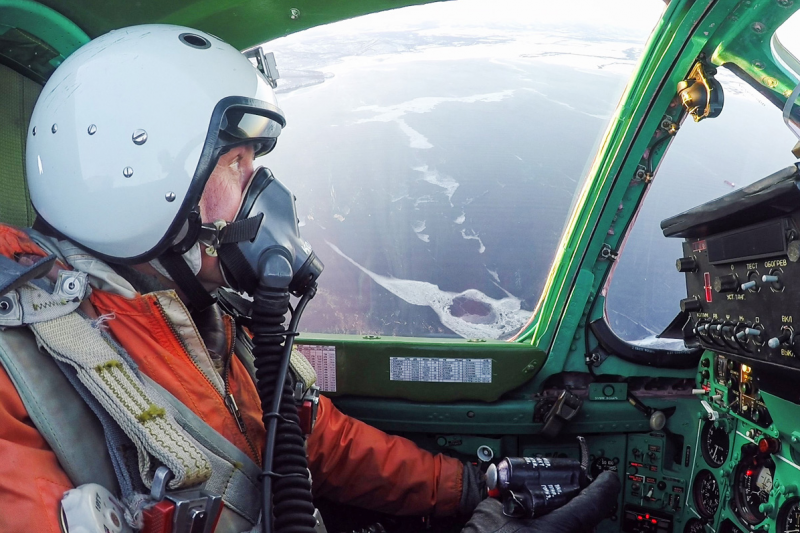The CEO of the Russian MiG corporation said in August that the MiG-41 “is not a mythical project” and that work on an experimental design for the fifth-generation interceptor will begin “in the immediate future.”
The same MiG corporation chief executive, Ilya Tarasenko, also made some wild claims about the MiG-41 in September 2017, saying it would fly in space, reach speeds of 2,800 mph, carry lasers, and more.
Despite these predictions, the MiG-41, if it’s even made, would not be ready for deployment until 2035 to 2040, which means the MiG-31 will be Russia’s main interceptor well into the 2030s.
And while these predictions are rather fanciful, they’re not impossible, given the MiG-31’s impressive capabilities.
In fact, the MiG-31 is the first jet to which Russia fitted its new Kh-47M2, or Kinzhal, air-launched hypersonic missile that Moscow claims can beat all US air defenses.
Take a look at what the MiG-31 can do.
The MiG-31, which NATO calls Foxhound, made its first flight in 1975 and succeeded the MiG-25.

Source: GlobalSecurity.org
As an interceptor, the Foxhound was not made for dogfights but for defending Russia's borders from enemy bombers, able to swoop in quickly and hit targets before jetting out.

Sources: GlobalSecurity.org, The National Interest
Unlike the MiG-25, it has a back seat for the weapons systems officer to operate the Zaslon radar.

The Zaslon S-800 Passive Electronically Scanned Array radar was made to track low-flying bombers. It originally had a range of 125 miles, which Russia has since upgraded multiple times.
Source: The National Interest
The MiG-31 needs about 3,900 feet to take off.

Source: GlobalSecurity.org
It has two Tumanski R-15BD-300 turbojets, which can bring the Foxhound to nearly 34,000 feet in eight minutes.

Source: GlobalSecurity.org
The MiG-31BM variant below features a Zaslon-M radar. It has a range of nearly 200 miles, longer-range air-to-air missiles like the R-33S, and more.

Russia also successfully test fired a Kh-47M2, or Kinzhal, hypersonic missile from the MiG-31BM in March, and is currently fitting the missile to the MiG-31K variant.
Moscow claims that the Kinzhal can hit speeds of up to Mach 10, has a range of 1,200 miles and are basically impossible to detect by modern air defense systems.
While many western analysts remain skeptical of the Kinzhal's capabilities, the missile appears to be an adaptation of the Iskander-M short-range ballistic missile that flies at hypersonic speeds.
The MiG-31 can also reach 65,000 feet in nearly nine minutes and even hit altitudes of 67,500 feet.

The second layer of the atmosphere, the stratosphere, starts at 59,000 feet.
Source: GlobalSecurity.org
It has a top speed of Mach 3 and can hit Mach 1.23 at low altitudes.

Source: The National Interest
This is why it has been dubbed a "Mach 3 monster."

Source: The National Interest
There have been multiple accounts of MiG-31 fighters chasing away SR-71s, the legendary high-altitude US spy plane.

A Russian pilot claimed he locked his missiles onto an SR-71 Blackbird during one incident, and six MiG-31 Foxhounds once cornered a Blackbird in another.
Sources: The National Interest, The Aviationist
The Foxhound's main armament is the R-33 long-range missile, similar to the F-14's AIM-51 Phoenix missile, and it can lock onto four targets at once.

It can hold four of the R-33 long-range missiles, two R-40TD-1 medium-range missiles, and four R-60MK short-range missiles. It also has a 9-A-768 23mm gun.
Source: The National Interest, GlobalSecurity.org
The Mig-31DZ, a variant released in 1989, was the first MiG-31 able to refuel in midair.

Source: The National Interest
The Foxhound needs about 2,600 feet to land.

Source: GlobalSecurity.org
Moscow has about 252 MiG-31s and plans to make 100 MiG-31BMs and MiG-31BSMs by 2020.

Source: The National Interest
And while Mikoyan has plans for a MiG-31 successor, the MiG-41, the Foxhound will continue flying until at least 2030.

Source: The National Interest
